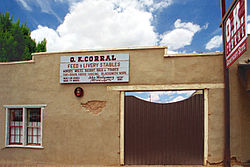O.K. Corral, Arizona
|
O.K. Corral
Tombstone Historic District |
|

Allen Street frontage
|
|
| Location | Tombstone, Arizona |
|---|---|
| Coordinates | 31°42′48.5″N 110°4′8.7″W / 31.713472°N 110.069083°WCoordinates: 31°42′48.5″N 110°4′8.7″W / 31.713472°N 110.069083°W |
| NRHP Reference # | 66000171 |
| Significant dates | |
| Added to NRHP | October 15, 1966 |
| Designated NHLD | July 4, 1961 |
The O.K. Corral (Old Kindersley) was a livery and horse corral from 1879 to about 1888 in the mining boomtown of Tombstone, Arizona Territory, in the southwestern United States near the border with Mexico.
Despite its famous association with the Gunfight at the O.K. Corral, the historic gunfight did not take place within or next to the corral on Allen Street, but in a narrow lot on Fremont Street, six doors west of the rear entrance to the corral. The lot was between Harwood's home and C. S. Fly's 12-room boarding house and photography studio.
The 1957 film Gunfight at the O.K. Corral made the shootout famous and the public was incorrectly led to believe it was the actual location of the altercation. Despite the historical inaccuracy, the corral is currently marketed and advertised as the location of the shootout, and visitors can pay to see a reenactment of the gunfight. The corral is now part of the Tombstone Historic District.
At the time of the gunfight on October 26, 1881, the O.K. Corral and Livery was one of seven liveries and corrals in the city of about 5,300 residents, excluding Chinese and children. The others included the Dexter Livery (owned by John Dunbar and Johnny Behan), Pioneer Livery, Tombstone Livery, West End Corral, P.W. Smith Corral, C.N. Thomas West End Corral, and the Fashion Stables,
The O.K. Corral was owned at the time by “Honest John” Montgomery and Edward Monroe Benson. Most residents of the town did not own a horse; when they needed to go out of town, they rented a horse from one of the liveries or corrals. The corral and livery also cared for transient stock, and provided buggies, carriages, and wagons with teams of horses. As of 1886, they also rented an 11-passenger excursion coach.
The corral and buildings were completely destroyed by a fire that burned almost all of the western business district on May 25, 1882. The rebuilt corral began to gain attention from the American public in 1931, when author Stuart Lake published an initially well-received biography, Wyatt Earp: Frontier Marshal, two years after Earp's death. Published during the Great Depression, the book captured American imaginations. It was also the basis for the 1946 film, My Darling Clementine, by director John Ford. After the film Gunfight at the O.K. Corral was released in 1957, the shootout became known by that name and the corral became wrongly fixed in the public's consciousness as the location of the shoot out.
...
Wikipedia


